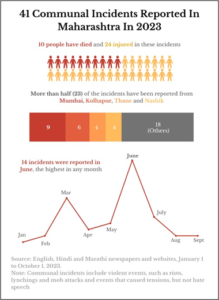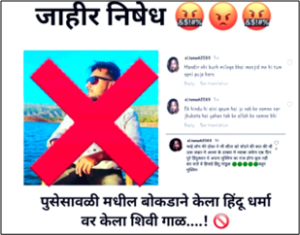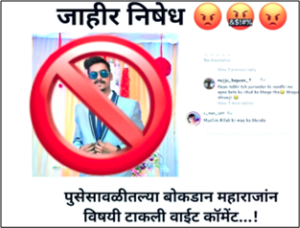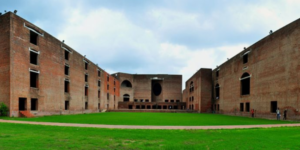Mumbai: From right-wing Hindu mobs vandalising mosques and lynching a Muslim engineer in Satara’s Pusesavali village in early September over a social media post, to Ram Navami processions leaving violence in their wake, India’s richest state has recently experienced an unusual orgy of violence.
Over the last nine months, there have been at least 41 incidents of a communal nature—riots to lynchings to rallies that stoke tensions—that culminated in tensions and violence, according to an analysis of media reportage by Article 14. At least ten were killed and scores injured in these incidents.
Apart from these violent events, Maharashtra also notched up another record—as the state with the highest number of hate speeches nationwide. In the first six months of 2023 there were 74 hate speeches, representing 30% of the 255 reported across India, according to Hindutva Watch, an online database.

In other words, there is one hate speech delivered every 2.5 days in Maharashtra. Karnataka came a distant second, with 26 hate speeches, followed by Madhya Pradesh with 25.
Mumbai, India’s financial capital, registering the highest number of such instances, with 9 of 41 incidents reported statewide. These include a mob attacking a Muslim man at a commuter rail station chanting Jai Shri Ram, and the desecration of Christian graveyards and religious symbols. Kolhapur ranked next, with 6 incidents.
In April 2023, the Supreme Court termed hate speech a “serious offence” and had ordered all states and union territories to take “suo moto action… to register cases” without formal complaints. Yet, the police in Maharashtra have rarely acted against such speeches, which have played a leading role, said experts, in creating a fertile atmosphere for tension and violence.
Political scientist Suhas Palshikar called the police’s inaction as part of a “template borrowed from other states” that has experienced rising communalism.
“The template is quite familiar by now, where you have a completely politically-controlled force which has to allow a certain amount of political inflammation,” said Palshikar, referring to hate speech.
“If things persist this way in Maharashtra, the next step would be the absolute communalisation of the police force, where people won’t even be able to expect minimal protections from the police,” said Palshikar.
Raqib Naik, journalist and founder of Hindutva Watch, an online database of hate crime and hate speech, described the scale of mobilisation by Hindutva groups in such events “scary”.
“People of all ages, including children, men, and women, are marching together and participating in anti-Muslim hate rallies that openly advocate violence,” Naik told Article 14. “The explicit calls for violence at many of these rallies indicate that groundwork is being laid to spark riots before elections, serving both ideological and electoral purposes.”
Article 14 sought comment from Maharashtra’s additional director general, law and order, Sanjay Saxena, sending him text messages. We will update this story if he responds.
‘Gouge Their Eyes Out’
These data come in the face of a concerted push by Hindu right-wing organisations, egged on by the ruling Bharatiya Janata Party (BJP), to peddle a divisive Hindutva agenda in Maharashtra, a fact not hidden by the speeches its members have made.
Bharatiya Janata Party (BJP) legislator Nitesh Rane, in July this year, speaking at a rally in the western district of Ahmednagar, urged listeners to “gouge the eyes out” of anyone who looked at Hindus with “an evil eye”.
“Gouge their eyes out and give them to me. I will ensure you get back home safely,” said Rane.
Rane’s speech came just weeks after Ahmednagar district two separate incidents of communally-charged violence. In May, Hindus and Muslims clashed after a procession celebrating the birth anniversary of Sambhaji Maharaj passing before a mosque in the town of Shevgaon set off violence and arson. Five people were injured, 20 shops and 20 cars vandalised.
In April, Hindu-Muslim violence had broken out in Ahmednagar’s Warulwadi, allegedly over a controversial status posted on WhatsApp by a local. The violence that ensued led to stone-pelting, injuring four and damaging vehicles.
Yet, Rane, visiting Shrigonda, just over an hour away from Warulwadi stokes anger and hate against the Muslim community, on the basis of conspiracies he does not over proof of. Like insisting that Muslims had launched a global conspiracy to convert India into an Islamic nation.
“By 2047, they don’t want to uphold the constitution,” Rane told his audience. “They want Sharia law in the country, they want the majority to be Muslims and they have already started working on that front.”
At least 50 Hindu jan aakrosh morcha or “people’s anger” rallies were held in Maharashtra between November 2022 and March 2023, the Indian Express, reported in March. These rallies were organised by recently-cropped up amorphous and leaderless Hindu right-wing organisations, chief one being ‘Sakal Hindu Samaj’, purportedly an umbrella group of other Hindutva bodies.
“Each of these events has followed a set pattern: a brief march through the heart of the city, amid a sea of saffron flags and caps, followed by a short rally, where speakers on a makeshift dais attack minorities, invoke “love jihad”, “land jihad”, “forced conversions”, and call for the economic boycott of the Muslim community,” the Indian Express reported.
A Common Factor: BJP Support
The common factor in many of these rallies is the presence and backing of the BJP. Senior leaders of the party have attended and promoted these rallies and delivered hate speeches themselves, according to our analysis.
Palshikar, the political scientist, said the timing of this rising hate had a lot to do with the political dynamics in Maharashtra.
“It is happening at a juncture when the BJP is in a critical situation and is seeking to ground itself as the single-largest party in Maharashtra,” said Palsikar. “So, no matter who organises these events, they feed into the politics of the BJP and directly benefit the party.”
Those spotted at these Islamophobic rallies include BJP Mumbai chief Ashish Shelar, BJP members of the legislative assembly (MLAs) Geeta Jain, Shivendra Raje Bhosale, former minister and MLA Ganesh Naik and current state ministers Atul Save and Sandipan Bhumre. A regular at these events is MLA Nitesh Rane, son of union micro, small and medium enterprises minister Narayan Rane.
Nitesh Rane has repeatedly goaded Hindu crowds towards violence against Muslims and assured them of protection.
“He Hindutva-wadi vichaaranche sarkaar aahe. Kuthlya hi Hindu la Maharashtra madhe waakdya najre ni paahila na, te dole parat mi te jaagewar thevnaar nahi, haan shabd tumhala deto. Tyaana mahiti he ki mi ugach dhamkiyan denara naahi… (This is a government based on Hindutva thought. Anyone who looks at Hindus in Maharashtra with an evil eye, we will ensure those eyes don’t remain in their place. And they know I am not a man who delivers empty threats,” Nitesh Rane said at a jan aakrosh rally in western Maharashtra’s Kolhapur on 2 November 2022.
“Raise your voice as Hindus, unite as Hindus. Tomorrow, how to get you back home safely is Nitesh Rane’s responsibility. This is my word. Devendra Fadnavis is sitting there as home minister, remember that”, he said, referring to the former chief minister, now deputy chief minister and who, as home minister, heads the state’s police department.
“A man with Hindutva-vadi thoughts, a bitter Hindutva,” Nitesh Rane said, to hooting and clapping. “This Hindutva-vadi man is sitting there as home minister. That is why I tell you, do not worry at all.”
Article 14 sought comment from Rane, through repeated text messages but he did not respond.
In June 2023, Fadnavis appeared to blame communal riots in Maharashtra on an Opposition “conspiracy”.
“Some politicians had been saying that there could be a riot-like situation in the state,” said Fadnavis. “Responding to the comments of these leaders, youths of a particular community showcased pictures of Aurangzeb. “They also glorified Aurangzeb and Tipu Sultan. It cannot be a mere coincidence.”
Fadnavis was referring to incidents where Muslims had posted (here, here and here) on social media or messenger applications praises of Mughal emperor Aurangzeb, sparking protests from local Hindu right-wing organisations and police registration of first information reports (FIRs), first steps to a criminal investigation.
Instead of condemning the violence triggered by these posts, Fadnavis blamed those accused of posting these praises.
“Maharashtra me achanak kuch jilo me Aurangzeb ki auladien paida hui hain (In some districts of Maharashtra, some children of Aurangzeb have suddenly been born),” said Fadnavis, who has never criticised Hindu right-wing mob attacks and rallies that forced families to flee the villages, that followed these posts. “They are posting pictures and status on social media of Aurangzeb, which is causing ill-will in society.”
Article 14 sought comment from Fadnavis through multiple text messages. We will update this story if he responds.
Ministers Fan The Flame
While Maharashtra has burned, some of Fadnavis’ colleagues in the state government have publicly fanned the flames.
Even as Hindu right-wing organisations spead hate, suspicion and anger against Muslims by alleging conspiracies, such as ‘love jihad’, Maharashtra women and child welfare minister Mangal Prabhat Lodha, claimed in the Maharashtra legislative assembly, without offering evidence, that there were 100,000 “love jihad cases”, the conspiracy theory that suggests Muslim men marry Hindu women to convert them to Islam.
Lodha even set up a government panel to track inter-faith marriages and gather data around them. In January 2023, Article 14 reported how the move to track interfaith marriage was unconstitutional and further endangered women.
In March 2023, a right-to-information query filed by Samajwadi Party MLA Rais Shaikh revealed that the panel had not received a single complaint about so-called ‘love jihad’ cases, despite Lodha’s claims.
Shaikh filed a public interest litigation in the Bombay High Court, challenging the establishment of the panel. “It is clear that the BJP has been, through announcements like this panel and the hate speeches, is trying to polarise voters in Maharashtra,” Shaikh told Article 14. “This seems to be a ploy to counter the effect of a consolidated opposition in the state.”
In June 2023, Fadnavis doubled down on the issue and alleged “a large number” of “love jihad” cases had been found in the state. He offered no evidence. Fadnavis said the government was considering a law to counter ‘love jihad’.
“Instances of innocent girls being lured into inter-religious marriages and (subsequent) exploitation are coming to light,” said Fadnavis. “We are concerned and will crack the whip.”
Such assertions by the state’s ministers, coupled with hate speeches and active backing for rallies and related events against Muslims, have translated into an environment of impunity.
In Malwani, Suspicion Replaces Coexistence
In March this year, as the festival of Ram Navami to celebrate the birth of Lord Rama neared, there was much enthusiasm in the low-income neighbourhood of Malvani in northwest Mumbai, a 1,200-acre sprawl of Hindu and Muslim homes, four times larger than Dharavi, long known as Asia’s largest slum.
Anwar Shaikh, president of the Jamaat-e-Islami’s Malvani chapter, remembers the rumours that were swirling among his Hindu and Muslim friends. “There was talk about how ‘something big’ was going to happen during the Ram Navami festival this year,” said Shaikh.
No one knew what was coming, but nearly everyone knew why these rumours were rife. Malvani, where coexistence had once been the norm, had been on the edge for many months. Shaikh and other locals, Hindu and Muslim, said they had noticed the BJP’s focus on the area. Many found it disconcerting.
During the Ram Navami festival of 2022 in April, a procession with BJP leaders deliberately outside a local mosque and chanted religious slogans, such as Jai Sri Ram. Former BJP councillor Vinod Shelar, brother of the party’s city chief Ashish, along with a local BJP leader, Tejinder Singh Tiwana, allegedly insisted on playing loud music outside the mosque. They were among 20 people against whom the Mumbai police filed FIRs.
In January 2022, top BJP leaders, including the local member of Parliament (MP) Gopal Shetty, Lodha, local MLA Atul Bhatkalkar among others were booked for “unlawful assembly, rioting, wrongful restraint and violating COVID-19 guidelines”, after they held protested the inauguration of a refurbished sports complex in the area, alleging it was named after Tipu Sultan, the 18th-century Muslim ruler of the kingdom of Mysore.
BJP and Hindu right-wing workers “blocked roads and punctured tyres of two public buses”, the Indian Express reported.
In October 2021, Lodha, then the party’s BJP state chief, went to the police station with Nitesh Rane and alleged that there was an exodus of Hindus from Malwani. “Immigrant Muslims are creating fear in the area and are coercing Dalit Hindus to flee,” he was quoted as saying.
This is why, when 30 March 2023, as Ram Navami drew closer, locals in Malvani kept their fingers tightly crossed. What happened next is a matter of dispute.
Only Muslims In Police FIR
According to a police chargesheet, a Ram Navami procession was making its way across Malvani when a Muslim man tried to hurl chappals and stones at the processionists but was detained. After questioning him, the police claimed they uncovered a wider “conspiracy”. They alleged in the chargesheet that a mob Muslims had gathered outside Savera Heights, a building adjoining the Hazrat Ali Masjid.
“A few days ago, a meeting was held (among Muslims) where it was decided that they had to avenge last year’s Ram Navami clashes,” the chargesheet said. “So, they decided that the boys would pick a fight with the procession at Jama Masjid and then, they would all gather outside Savera Heights.”
The police said they “cleared” the road outside Savera Heights, so the procession could go through. “However, the accused made an illegal assembly and when the procession reached Savera Heights, they shouted ‘Allah-u-Akbar’ repeatedly, hurling shoes and stones at the processionists,” the chargesheet said.
Locals remember the events of 30 March differently.
Shaikh, who said he was there, described the procession halting outside the Hazrat Ali Masjid and playing “provocative” music. “They were loud, provocatively-chanted slogans of Jai Shri Ram, right outside the mosque,” he said.
Videos (here and here) viewed by Article 14 showed a procession of thousands passing in front of the mosque slowly, playing a popular Hindutva pop song, Main Hindu jagaane aaya hu (I’ve come to wake up Hindus).
Matrubhoomi ki raksha karne,
Hum talwar uthayenge.
Jay shri Ram, Jay shri Ram,
Milkar bolo Jai Shri Ram!
To protect our motherland,
We will pick up swords, no doubt.
Jai Shri Ram, Jai Shri Ram,
Say together, Jai Shri Ram!
As the procession slowly made its way past Savera Heights, Muslims gathered in the compound hurled footwear. In response, Hindu processionists also hurled footwear. Inside Savera Heights, Muslims formed a human chain and ensured the hurling of footwear did not descend into a physical clash.
In the videos, Jamil Merchant, a local businessman and a resident of Savera Heights, walks around with a wooden stick, trying to control the mob inside the building, stopping it from going towards the procession.
The police, Merchant said, expressed gratitude. “Senior police officials came and thanked me,” he said, pointing to a view of police officials shaking his hand with smiles, just minutes before the shoe-throwing, “and told me how I had ensured the situation would not escalate.”
Except, later that night, Merchant was named as the prime accused in an FIR the Malvani police filed, accusing him, 12 others—all Muslim—and “300-400” unidentified persons of rioting, “promoting enmity between groups”, criminal conspiracy, causing “grievous hurt to deter public servants”, among 15 others under sections of the law.
The FIR did not name anyone from the Ram Navami procession, despite videos and local testimonies that said the processionists threw shoes, stones and sticks.
Article 14 sought comment over text and WhatsApp messages from the local deputy commissioner of police Ajay Kumar Bansal. We will update this story if he responds.
In Malvani, such selective action, coming on what many see as a concerted attempt by the BJP to saturate the area with Hindutva propaganda, has vitiated the atmosphere between communities.
“We agree that it was the Muslim side that started it, but it is not fair to only target Muslims, while ignoring the role of the processionists in the clash,” said Shaikh.
Ignoring Islamophobia To Fatal Effect
On 18 August 18 2023, a screenshot of a social media comment, ostensibly made by a Muslim youth, Adil Bagwan, went viral in and around the village of Pusesavali in the western Maharashtra district of Satara.


Such photos, containing comments ostensibly made by Muslim youth from the village of Pusesavali about Maratha emperor Shivaji and Hindu gods, were circulated by Hindu right-wing organisations in the village before the attack on the village mosque and homes of Muslims, one of whom died.
Bagwan was arrested by the Aundh police station for his comments, a mob of local Hindus and outsiders—more outsiders than locals, said locals—held a nishedh (protest) morcha in the village.
The protest worried local Muslims, since the protesters gathered outside their homes, said Ashpak Bagwan, a journalist, related to the accused, Adil Bagwan.
Four days after the post went viral, on August 22, Ashpak Bagwan wrote letters to the local superintendent of police, the district’s guardian minister, Shambhuraje Desai, from the ruling Shiv Sena, the district collector, the Khatav magistrate and police from the local Aundh police station.
Ashpak Bagwan worried that matters would escalate and named five persons as the key movers of the protest. “In the future, if these people try and harm me, my family, and members of my community, its women, men and youth, they will be entirely responsible for it,” said the letter. “Hence, please carry out necessary and restrictive action against these people so that we can live without terror.”
None of those named in Ashpak Bagwan’s letter were arrested or otherwise acted against.
Article 14 sought comment over WhatsApp and text messages from Satara superintendent of police Samir Sheikh. We will update this story if he responds.
Ashpak Bagwan’s fears came true. On 10 September, another screenshot went viral, showing a comment by another village youth, Altamash Bagwan (no relation), on an Instagram post with derogatory references to Hindu gods.
Even as the police detained Altamash, a mob consisting of Hindus from within and outside the village had already gathered in Pusesavali.
According to the police FIR, the mob ransacked Muslim-owned fruit and juice shops and headed to the village mosque. A mob of Hindus entered the mosque with lathis, iron rods and stones, according to the FIR, chanting Jai Shri Ram and attacking Muslims who had gathered for namaz.
The mob even attacked policemen gathered there and vandalised and burnt vehicles outside the mosque.
The mob attack claimed the life of a local 32-year-old Muslim man, Nurul Hasan, unconnected with the incident, who had gone to the mosque for his evening prayers.
The Aundh police FIR filed after Hasan’s murder, named 27 Hindus and 100 other “unidentified persons” and accused them of murder, attempt to murder, rioting, being armed with deadly weapons among 13 other sections of the law.
For Ashpak Bagwan, the journalist, the FIR was bittersweet: of the 5 people he had warned the police about in his letter, 3 were now accused of killing Hasan.
“We had warned the police that these people clearly had evil designs and were looking to exploit the situation to further divide society,” said Ashpak Bagwan. “But the police ignored us, till things got out of control.”
Note: News sources used in the analysis for this story: Hindustan Times, Indian Express, The Times of India, The Print, Newslaundry, The Quint, NDTV, The Free Press Journal, Sabrang India, The Siasat Daily, Hindutva Watch, Madhyamam, Scroll, Maktoob Media, Deccan Herald, The Wire.
(Kunal Purohit is an independent journalist and the author of an upcoming non-fiction book on Hindu right-wing politics, titled ‘H-Pop: Inside The Secretive World of Hindutva Popstars’. Article courtesy: Article 14.com, a joint effort between lawyers, journalists, and academics that provides intensive research and reportage, data and varied perspectives on issues necessary to safeguard democracy and the rule of law.)




